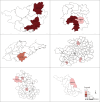Epidemiological characteristics of human rabies cases reported by sites in China from 2006 to 2022
- PMID: 39272017
- PMCID: PMC11395948
- DOI: 10.1186/s12879-024-09864-2
Epidemiological characteristics of human rabies cases reported by sites in China from 2006 to 2022
Abstract
Background: Rabies is an incessant public health threat in China. The Ministry of Health implemented the Central Payment for Rabies Prevention and Control Project to assist with rabies prevention and control in a few representative provinces in 2006.
Methods: Data on human rabies cases reported by the National Infectious Disease Reporting Information Management System and national surveillance sites from 2006 to 2022 were collected, and statistical and multivariate analyses were then used to assess the effectiveness of current prevention and control efforts.
Results: During 2006-2022, a total of 2025 human rabies cases were collected by the national surveillance sites, with incidence rates far above the national average, but the incidence rate was consistent with the national trend. Human rabies cases demonstrated a dual peak distribution in terms of exposure and onset dates, with the peak exposure dates falling mostly in the spring and summer and the peak onset dates occurring mostly in the summer and autumn. Three danger categories are shown by the geographical distribution: high, medium and low. Dogs had a high infection rate (86.93%), with own domesticated dogs accounting for the majority of infections. The rates of post-exposure prophylaxis are not constant. The median incubation period was 71 days.
Conclusions: Various measures and policies implemented by the government have played a key role in reducing the incidence of rabies. To effectively prevent and control the resurgence of epidemics and halt the spread of the virus among host animals, it is imperative to prioritize and implement a robust dog management system, accelerate research and development of animal vaccines and improve the level of post-exposure prophylaxis.
Keywords: Epidemiologic characteristics; Influencing factor; Post-exposure prophylaxis; Rabies.
© 2024. The Author(s).
Conflict of interest statement
The authors declare no competing interests.
Figures





Similar articles
-
Epidemiological characteristics and post-exposure prophylaxis of human rabies in Chongqing, China, 2007-2016.BMC Infect Dis. 2018 Jan 3;18(1):6. doi: 10.1186/s12879-017-2830-x. BMC Infect Dis. 2018. PMID: 29295708 Free PMC article.
-
[Epidemiological characteristics of human rabies in China, 2017].Zhonghua Liu Xing Bing Xue Za Zhi. 2019 May 10;40(5):526-530. doi: 10.3760/cma.j.issn.0254-6450.2019.05.007. Zhonghua Liu Xing Bing Xue Za Zhi. 2019. PMID: 31177732 Chinese.
-
Human rabies surveillance and control in China, 2005-2012.BMC Infect Dis. 2014 Apr 18;14:212. doi: 10.1186/1471-2334-14-212. BMC Infect Dis. 2014. PMID: 24742224 Free PMC article.
-
Progress towards dog-mediated rabies elimination in PR China: a scoping review.Infect Dis Poverty. 2023 Apr 6;12(1):30. doi: 10.1186/s40249-023-01082-3. Infect Dis Poverty. 2023. PMID: 37024944 Free PMC article.
-
The role of vaccination in rabies prevention.Curr Opin Virol. 2012 Jun;2(3):309-14. doi: 10.1016/j.coviro.2012.03.007. Epub 2012 Apr 11. Curr Opin Virol. 2012. PMID: 22503445 Review.
Cited by
-
The temporal shift of temperature-related injury incidence risk and its driving factors in China: a nationwide case-crossover study from 2006 to 2021.Lancet Reg Health West Pac. 2025 Jun 4;59:101590. doi: 10.1016/j.lanwpc.2025.101590. eCollection 2025 Jun. Lancet Reg Health West Pac. 2025. PMID: 40525128 Free PMC article.
-
One-step ahead: evaluating the efficacy of single-visit rabies pre-exposure prophylaxis against conventional multi-visit protocol: a randomized non-inferiority clinical trial.Trop Dis Travel Med Vaccines. 2025 Aug 7;11(1):25. doi: 10.1186/s40794-025-00262-3. Trop Dis Travel Med Vaccines. 2025. PMID: 40770667 Free PMC article.
References
-
- Bourhy HCF, Fooks A, Muller T, Hatz C, Fehlner-Gardiner C et al. WHO Expert Consultation on rabies, third report. WHO Tech Ser Rep 2018, 1012(Geneva):2018.
MeSH terms
Substances
LinkOut - more resources
Full Text Sources
Medical

